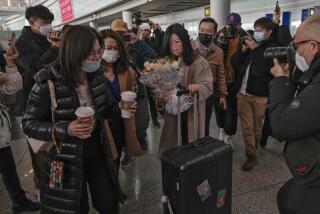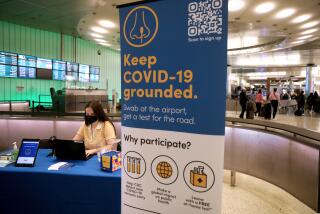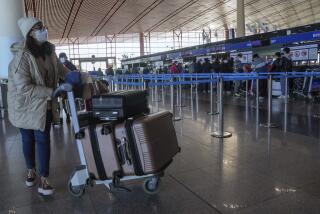Coronavirus screenings to begin at LAX, two other U.S. airports amid outbreak in China
Federal authorities will begin screening airline travelers arriving from Wuhan, China, for signs that they may be infected with a new coronavirus that is spreading in Asia, officials announced Friday.
Passengers flying into Los Angeles International Airport, San Francisco International Airport and John F. Kennedy International Airport in New York will be examined for the virusâ pneumonia-like symptoms, the Centers for Disease Control and Prevention said.
About 100 additional CDC workers will be deployed to join existing public health staff at the three airports.
The newly evolved virus, known as 2019-nCoV, has sickened at least 41 people and killed two since December. Health authorities in Thailand and Japan have each identified infected patients as well. In at least two of those three cases, the patients had recently traveled to Wuhan, the epicenter of the outbreak.
The likelihood that the virus will spread within the United States is still considered low. However, public health officials are concerned that the virus could spread more widely as travel picks up in advance of the Chinese New Year.
âInvestigations into this novel coronavirus are ongoing and we are monitoring and responding to this evolving situation,â Martin Cetron, the head of the CDCâs Division of Global Migration and Quarantine, said in a statement Friday.
According to Chinese health officials, most patients infected with the virus in Wuhan were exposed to live animals in a large seafood market, which suggests that the virus jumped from another host species into humans.
But at least two patients said they had not visited the market, which has since closed â a concerning sign that the virus has taken hold in humans and could be poised to spread more widely.
âItâs encouraging that this virus doesnât appear to be easily transmitted between humans, if it all. But you worry that, over time, it could,â said Dr. Robert J. Kim-Farley, an epidemiology professor at UCLA who formerly led infectious disease control at the LA County Department of Public Health.
The airports in San Francisco and New York receive direct flights from Wuhan. LAX does not, but the CDC surveillance there will focus on passengers arriving through connecting flights, an airport spokeswoman said.
Health workers will scan passengersâ foreheads for fevers and will collect questionnaires that ask whether the travelers have visited markets in Wuhan or experienced other symptoms of the virus, such as difficulty with breathing.
Screenings will begin on Friday night in New York and on Saturday at the two California airports. Based on travel projections, authorities expect some 5,000 passengers to be screened at the three airports in the coming weeks.
Border screenings can be controversial because they are expensive and only partially effective, according to Alexandra Phelan, a health policy expert at Georgetown Universityâs Center for Global Health Science and Security. Since some disease can be transmitted without showing symptoms, âsymptom-based screening alone will be insufficient,â she added.
Still, federal officials said they are operating out of an abundance of precaution.
âWhen you have an emerging infectious disease, you want to be able to detect cases as early as you possibly can,â said Nancy Cox, who led the influenza division at the CDC during the 2009 swine flu pandemic. Public health officials âdo this at airports because, if the risk increases, you already have the precautions in place, experienced people doing the screenings, and an increased level of awareness generally.â
Some coronaviruses cause mild respiratory infections, like the common cold. But others lead to far more severe symptoms. MERS, for example â another respiratory illness caused by a coronavirus â has had a fatality rate of up to 40% in Saudi Arabia and other Middle Eastern countries, where it has been circulating over the last decade.
Chinaâs 2003 outbreak of severe acute respiratory syndrome, a coronavirus known as SARS, was believed to have originated through animal-to-human transmission in a marketplace, much like the scenario in the Wuhan outbreak. The virus ultimately killed about 800 people worldwide, including 44 in Canada. (There were no SARS deaths in the United States.)
Health experts say that open communication between Chinese officials and foreign health leaders will be vital to squelching the Wuhan outbreak. In 2003, the Chinese government admitted it had drastically underreported the number of SARS cases, causing a widespread public backlash and dismissals of the countryâs health minister and mayor of Beijing.
In 2005, Beijing officials obfuscated the scale of an H5N1 influenza outbreak that began when the virus jumped from chickens to humans, even in the face of contradictory evidence from Hong Kong. And again, in 2018, the Chinese government withheld lab samples of a rapidly evolving H7N9 bird flu virus from foreign governments that hoped to prepare for it.
Some experts believe the secrecy is motivated in part by a desire to protect Chinaâs poultry industry. Still, transparency and proactive steps â like the airport screenings â could make all the difference in containing the new coronavirus while the outbreak is still in its early stages, experts said.
âThis virus is of the same classification as SARS and MERS â it has the potential to be a serious organism. And because itâs new, we donât know much about it yet,â Kim-Farley said.
âPut this on the list of diseases that you really, really want to nip right in the bud,â he added.
More to Read
Sign up for Essential California
The most important California stories and recommendations in your inbox every morning.
You may occasionally receive promotional content from the Los Angeles Times.











